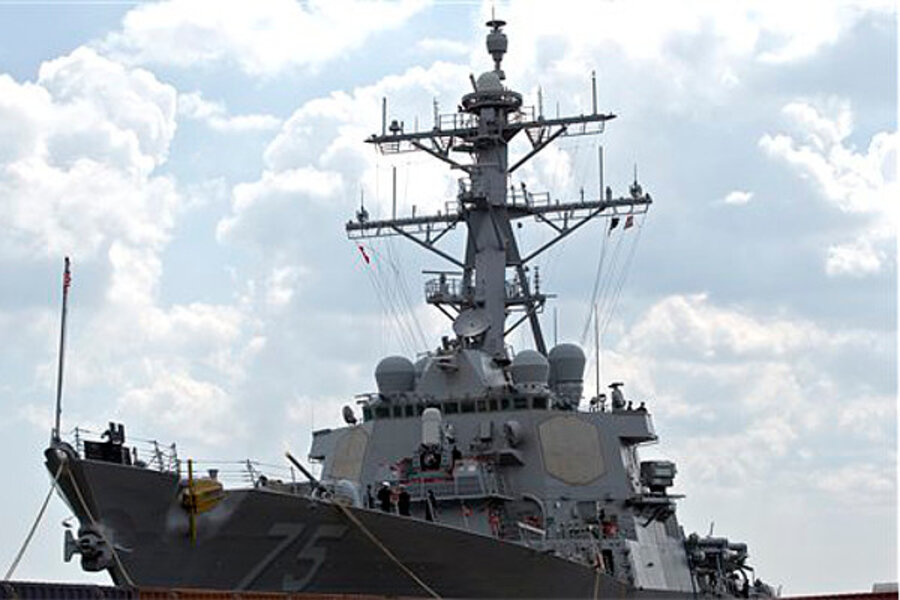Russian aircraft buzz US Navy destroyer: How big a deal?
Loading...
| Washington
When Russian attack aircraft buzzed the USS Donald Cook in the international waters of the Black Sea, even as tensions in the region ratchet up, Pentagon officials decried the move as “provocative.”
How big a deal are these “provocative” actions on the part of the Russian military – or were these just a couple of rogue Russian pilots out for a joy ride?
US military officials quickly dismissed the latter option. “I have difficulty believing that two Russian pilots, on their own, would choose to take such an action,” Col. Steve Warren said during a Pentagon briefing Monday.
“We’ve seen the Russians conduct themselves unprofessionally and in violation of international norms in Ukraine for several months,” he added.
During the cold war, these sorts of flybys “happened all the time,” says Christopher Harmer, a retired Navy officer who served as deputy director of future operations for the US Navy’s Fifth Fleet.
In fact, these kinds of incidents happen more often than ever makes it into the press, says Mr. Harmer, now a senior naval analyst with the Institute for the Study of War in Washington.
“We used to call it the ‘standard harassment package,’ ” and it was meant to send a message.
“It was their way of saying, ‘We the Russian military are still capable of monitoring the US Navy and still capable of putting ourselves in a position to harm you if it comes to that,’ ” he says.
Pentagon officials were quick to point out that the USS Cook “is more than capable of defending itself” against the Russian aircraft.
The incident, which took place Saturday, however, is “an overt reminder that this is their backyard,” Harmer adds, and that the Navy destroyer’s location in the Black Sea is “a long way from US Navy bases and at the front doorstep” of the Russian military.
The Russian aircraft flew within 1,000 yards of the ship and made roughly a dozen passes, but it did not fly over the destroyer, according to Pentagon officials.
“That is about as tame a flyby as you can get,” Harmer says. On the more aggressive end of the spectrum is a flyover of a ship such as an aircraft carrier, which happened on more than one occasion during Harmer’s time serving at sea.
That’s more dangerous because the airspace above an aircraft carrier “is very constrained,” he says, and a flyover can interfere with the ability of planes to land on the deck of the ship.
“The ship has got to be sailing directly into the wind, and it can’t really change course.” Harmer says. “That’s about as aggressive as you can get because you’re introducing safety into the operations.”
The Russian fighter jets that flew over the USS Cook “don’t have a lot of gas or a lot of endurance,” so US Navy officers could rest assured that the jets would not harass their ship for long.
On the other hand, there were times during Harmer’s service when the Russian military would park its reconnaissance aircraft above a ship – and such aircraft are “much bigger, longer range, with more endurance.”
In the Black Sea, with military bases nearby in Crimea, Russia could send aircraft to loiter above ships like the USS Cook for “eight to 10 hours,” Harmer says.
If that were to happen, US Navy ships could not conduct normal operations. This might mean that a ship would be prevented from sending out a drone that could take pictures of Sevastopol in the Crimean Peninsula, for example.
Or it could be prevented from rolling out equipment to do mapping of the Black Sea. “We’ve got pretty good maps of the Black Sea, but we could want more technical detail,” Harmer posits.
In response to loitering planes, the ships tend to reduce their speed to a minimum, and run slowly in big circles, while the reconnaissance aircraft do the same.
“You both just stare at each other,” Harmer says. “It might seem exciting, but it’s actually very boring.”







